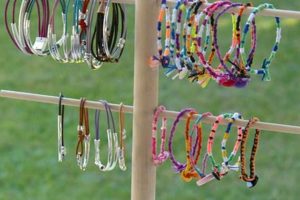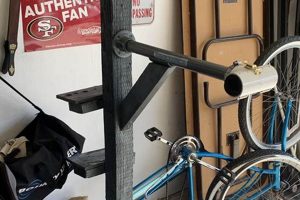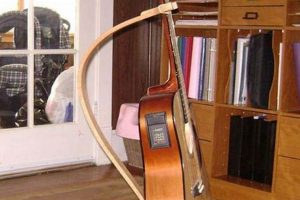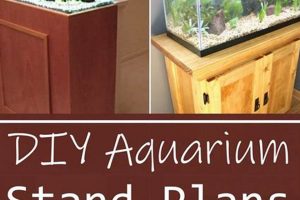The construction of a supportive structure designed to hold a standard 55-gallon fish tank, undertaken by the tank owner rather than purchased pre-made, is a common endeavor among aquarists. Such projects typically involve utilizing readily available materials and tools to create a stable and aesthetically appropriate base for the aquarium. An example would be building a wooden frame with a flat top, reinforced to withstand the substantial weight of a filled aquarium.
This approach offers considerable advantages, including cost savings and customization. Predesigned commercial stands may not always meet specific aesthetic requirements or offer the necessary storage space. Building independently allows for tailored dimensions, material selection, and integration of features such as shelving or enclosed cabinets. Historically, aquarium enthusiasts have embraced self-sufficiency, adapting woodworking and metalworking techniques to create functional and personalized habitats for aquatic life.
The following sections will delve into the critical aspects of planning, material selection, construction techniques, and safety considerations when undertaking this type of project. These details are essential for ensuring the structural integrity and longevity of the support system.
Construction Recommendations
The following recommendations address critical aspects of constructing a robust and reliable aquarium support structure. Adherence to these guidelines will contribute significantly to the project’s success and the safety of the aquarium.
Tip 1: Precise Load Calculation: Prior to any construction, determine the exact weight of a filled 55-gallon aquarium. Account for the weight of the glass, water (approximately 8.34 lbs per gallon), substrate, decorations, and any other items placed inside the tank. Overestimation is preferable to underestimation in this calculation to ensure sufficient structural capacity.
Tip 2: Robust Material Selection: Opt for high-quality lumber, such as kiln-dried pine or hardwood, known for its strength and resistance to warping. Avoid using particleboard or MDF for load-bearing components, as these materials are susceptible to moisture damage and structural failure under sustained weight. Steel framing offers an alternative with superior strength.
Tip 3: Secure Fastening Methods: Employ screws rather than nails for assembling the frame. Screws provide a stronger and more durable connection. Utilize wood glue in conjunction with screws to enhance the joint strength. Countersink the screw heads to prevent them from interfering with the tank’s placement.
Tip 4: Level and Stable Base: Ensure the stand rests on a perfectly level surface. Use shims if necessary to correct any unevenness. The goal is to distribute the weight of the aquarium evenly across the entire base of the stand, preventing stress points that could lead to failure.
Tip 5: Comprehensive Waterproofing: Apply a waterproof sealant or paint to all wooden surfaces to protect against spills and condensation. This will prolong the lifespan of the structure and prevent water damage, which can compromise the integrity of the wood.
Tip 6: Internal Reinforcement: Incorporate internal bracing and supports, particularly at the corners and along the center span of the stand. This will significantly increase the load-bearing capacity and prevent sagging or warping over time. Consider adding a center vertical support if the span is greater than 36 inches.
Tip 7: Uniform Weight Distribution: The top surface of the stand must be perfectly flat and uniform to ensure even weight distribution across the bottom of the aquarium. A layer of rigid foam insulation placed between the stand and the tank can help to compensate for minor imperfections and further distribute the load.
Implementing these recommendations will lead to a stronger, more reliable, and longer-lasting aquarium support system. Paying attention to load calculations, material selection, fastening methods, leveling, waterproofing, reinforcement, and weight distribution are all crucial for a successful build.
With these fundamental construction considerations addressed, attention now shifts to aesthetic design and finishing techniques that can complement the aquarium and its surrounding environment.
1. Load-bearing Capacity
Load-bearing capacity is a paramount consideration in the design and construction of a support structure for a 55-gallon aquarium. The integrity of the entire system hinges on the stand’s ability to safely and reliably support the substantial weight of the filled tank. Failure to adequately address this factor can result in catastrophic consequences, including structural failure and potential damage to property and aquatic life. The following facets illustrate key considerations.
- Material Strength and Selection
The choice of materials directly influences the ultimate load-bearing capacity. The type of wood, its thickness, and the quality of the fasteners employed determine the stand’s ability to resist deformation and failure under load. For example, using softwood like pine requires thicker dimensions and more robust bracing compared to hardwood options like oak or maple. Inadequate material selection compromises structural integrity and jeopardizes the aquarium’s safety.
- Joint Construction and Reinforcement
The method of joining structural members plays a vital role in distributing weight and preventing localized stress. Butt joints, commonly used in amateur constructions, offer minimal resistance to shear forces unless properly reinforced with gussets or metal brackets. Mortise and tenon joints, while more complex to execute, provide superior strength and stability. Regardless of the chosen method, proper joint construction is essential for maximizing load-bearing capacity.
- Weight Distribution and Support
Uniform weight distribution is crucial for preventing concentrated stress points that can lead to structural weakening. The support structure must provide continuous and even support across the entire base of the aquarium. Designs incorporating a central support column, particularly for wider tanks, help to mitigate deflection and ensure that the weight is evenly distributed across the frame. Uneven distribution can result in localized failure and eventual collapse.
- Safety Factor and Over-Engineering
A safety factor is a multiplier applied to the calculated weight of the filled aquarium to account for unforeseen loads, material imperfections, and variations in construction quality. Implementing a safety factor of at least 2:1 is advisable, meaning the stand should be designed to support at least twice the expected weight. Over-engineering the structure by incorporating additional bracing or using thicker materials provides an extra margin of safety and reduces the risk of failure over time.
These facets underscore the critical link between load-bearing capacity and the successful implementation of a support structure. Competent selection of materials, robust joint construction, uniform weight distribution, and the implementation of a generous safety factor contribute to a structure that exceeds the requirements for a 55-gallon aquarium. Overlooking these considerations poses significant risks, rendering the construction inadequate for the intended purpose.
2. Material Durability
Material durability directly impacts the longevity and reliability of a self-constructed aquarium support. The selection of appropriate materials capable of withstanding environmental stresses inherent in aquarium keeping is crucial for preventing premature degradation and potential structural failure. Material selection, therefore, requires careful consideration.
- Resistance to Moisture and Water Damage
Aquarium environments inherently involve exposure to water and humidity. Materials susceptible to rot, swelling, or corrosion when exposed to moisture are unsuitable for constructing an aquarium stand. For wooden stands, this necessitates the use of water-resistant lumber, such as cedar or redwood, or the application of multiple coats of waterproof sealant to prevent water absorption. Metal stands require corrosion-resistant coatings or alloys to prevent rust formation, which can compromise structural integrity over time. Failure to address moisture resistance can lead to rapid deterioration of the stand, jeopardizing the stability of the aquarium.
- Load-Bearing Capacity Over Time
Materials exhibit varying degrees of resistance to creep, the gradual deformation of a material under sustained load. A material selected for an aquarium stand must maintain its load-bearing capacity over the long term without significant sagging or deformation. For example, while some plastics may initially appear strong enough to support an aquarium, they can exhibit significant creep over time, leading to structural instability. Therefore, materials should be chosen based on their documented long-term load-bearing characteristics.
- Resistance to Chemical Degradation
Aquarium environments can contain various chemicals, including cleaning agents, medications, and trace elements. Some materials may be susceptible to degradation or leaching when exposed to these chemicals. This is particularly relevant for materials used in close proximity to the water, such as the stand’s top surface. Chemical degradation can weaken the material and contaminate the aquarium water. Therefore, material selection should consider chemical compatibility with common aquarium additives.
- Resistance to Physical Impacts and Wear
An aquarium stand is subject to potential physical impacts and wear, such as accidental bumps, scratches, and abrasion from cleaning activities. Materials prone to easy scratching or chipping may not maintain their aesthetic appeal over time and could potentially expose the underlying material to moisture or chemical attack. Durable materials with a high resistance to surface damage are preferred for maintaining both the appearance and structural integrity of the stand.
These durability considerations underscore the importance of meticulous material selection for the construction of an aquarium support. Choosing materials resistant to moisture, long-term load, chemical degradation, and physical wear contributes significantly to the safety, stability, and aesthetic appeal of the completed project. Disregard for these factors can result in costly repairs, potential aquarium failure, and compromise the well-being of aquatic inhabitants.
3. Structural Stability
Structural stability constitutes a critical factor in the successful construction of a support intended for a 55-gallon aquarium. The design and execution of a support framework must prioritize resistance to deformation, collapse, or any form of instability under the substantial weight of a filled aquarium. Inadequate structural stability poses a significant risk of catastrophic failure, potentially resulting in property damage and harm to aquatic life.
- Rigid Frame Construction
The foundation of structural stability lies in the creation of a rigid frame. This involves employing robust materials and secure joinery techniques to minimize flexing or swaying. For instance, a frame constructed from 2×4 lumber, properly joined with screws and adhesive, provides significantly greater rigidity compared to a frame assembled with nails or weaker materials. The absence of a rigid frame increases the likelihood of instability and potential collapse under the weight of the aquarium.
- Cross-Bracing and Shear Resistance
Cross-bracing, diagonal supports strategically placed within the frame, enhances resistance to shear forces that can cause the structure to deform laterally. Consider a scenario where a sudden impact occurs against the side of the stand. Without cross-bracing, the frame could buckle or collapse. Cross-bracing effectively distributes the force across the entire structure, maintaining its shape and integrity. Inadequately braced structures are particularly vulnerable to instability from external forces.
- Level Support Surface
A perfectly level support surface ensures that the weight of the aquarium is evenly distributed across the entire frame. Uneven weight distribution creates stress concentrations that can lead to localized deformation and eventual failure. Imagine placing an aquarium on a stand with a significant dip in the center. The center section of the aquarium’s base would bear a disproportionate amount of weight, increasing the risk of cracking or structural compromise. Achieving a level surface is therefore essential for maintaining stability.
- Vertical Load Path
A clear and direct vertical load path ensures that the weight of the aquarium is efficiently transferred from the top of the stand to the floor. This involves aligning vertical supports directly beneath the load-bearing points of the aquarium. For example, ensuring that the aquarium’s corners rest directly above vertical support posts allows the weight to be transferred straight down through the structure. An interrupted or misaligned load path can create bending moments and stresses that compromise stability.
These facets, including rigid frame construction, cross-bracing, level support surface, and a direct vertical load path, collectively contribute to the overall structural stability of an aquarium support. Neglecting any of these aspects increases the risk of instability and potentially catastrophic failure, highlighting the importance of careful design and construction when creating a support for a substantial aquarium.
4. Water Resistance
Water resistance is a critical consideration in the construction of a self-made support for a 55-gallon aquarium. The prolonged exposure to moisture, spills, and condensation inherent in aquatic environments necessitates the selection of materials and construction methods that mitigate water damage. Neglecting adequate water resistance can lead to structural degradation, fostering mold growth and ultimately compromising the integrity of the support structure.
- Material Selection for Moisture Exposure
The choice of materials directly influences the support’s susceptibility to water damage. Untreated wood, particularly softwood varieties, readily absorbs moisture, leading to swelling, warping, and rot. In contrast, naturally water-resistant lumber such as cedar or redwood provides inherent protection. Alternatively, applying waterproof coatings to susceptible materials, such as plywood or pine, offers a barrier against moisture penetration. The careful selection or treatment of materials is, therefore, essential for mitigating water-related degradation.
- Protective Coatings and Sealants
Protective coatings and sealants act as a primary defense against water intrusion. Application of multiple coats of a waterproof sealant or paint to all exposed surfaces creates a barrier that prevents moisture from reaching the underlying material. Specific attention should be given to joints and edges, as these areas are particularly vulnerable to water penetration. Regular inspection and maintenance of the coating, with reapplication as needed, is crucial for sustained protection. The selection of a coating compatible with the chosen construction materials is of paramount importance.
- Joint Sealing and Waterproofing
Joints represent potential points of water entry. Proper sealing of joints with waterproof adhesives or sealants prevents water from seeping into the structure’s interior. Mechanical fasteners, such as screws, should be used in conjunction with adhesives to create a watertight seal. The application of sealant to all seams and corners further minimizes the risk of water penetration. A meticulous approach to joint sealing is crucial for preventing hidden water damage that can compromise structural integrity.
- Ventilation and Air Circulation
Promoting adequate ventilation and air circulation around the support structure aids in moisture evaporation and reduces the risk of mold growth. Creating air gaps between the stand and the floor, or incorporating ventilation openings in the stand’s design, allows air to circulate freely. This is particularly important in enclosed cabinets or spaces where moisture can accumulate. Proper ventilation complements other water resistance measures, contributing to a drier and more stable environment for the support structure.
These considerations underscore the critical role of water resistance in the context of a self-built aquarium support. Prudent material selection, protective coatings, joint sealing, and adequate ventilation collectively minimize the risks associated with water exposure, thereby prolonging the lifespan and ensuring the stability of the support system. A failure to adequately address water resistance can lead to premature structural failure, jeopardizing the aquarium and its inhabitants.
5. Leveling Precision
Leveling precision represents a fundamental requirement in the construction and installation of a support structure for a 55-gallon aquarium. The consistent distribution of weight across the base of the aquarium is contingent upon a perfectly level support surface. Deviations from level can induce stress concentrations, potentially leading to structural compromise and catastrophic failure of the aquarium.
- Impact on Weight Distribution
An unlevel support surface causes uneven distribution of the aquarium’s weight. This concentrated load can exceed the structural capacity of the aquarium glass or the support stand itself. For instance, if one corner of the stand is lower than the others, the corresponding corner of the aquarium will bear a disproportionate amount of weight. This localized stress increases the risk of cracking or joint failure. Precise leveling ensures that the load is distributed uniformly across the entire base, minimizing stress and maximizing stability.
- Minimizing Stress on Aquarium Seams
Aquarium seams, typically constructed with silicone sealant, represent a vulnerable point in the tank’s structure. Uneven weight distribution exacerbates stress on these seams, potentially leading to leaks or complete seam failure. A level support surface ensures that the seams are subjected to minimal stress, prolonging their lifespan and reducing the risk of water leakage. Correcting even minor deviations from level can significantly decrease the stress on these critical joints.
- Long-Term Structural Integrity
Consistent, even weight distribution is crucial for maintaining the long-term structural integrity of both the aquarium and the support stand. Uneven weight distribution can cause gradual deformation or warping of the support structure over time. This, in turn, further exacerbates the stress on the aquarium, creating a feedback loop that accelerates structural degradation. Leveling precision promotes a stable and balanced system, minimizing the risk of long-term damage.
- Methods for Achieving Level
Achieving a perfectly level support surface requires the use of appropriate tools and techniques. Spirit levels, laser levels, and shims are essential for identifying and correcting deviations from level. Placing a level directly on the top surface of the stand reveals any discrepancies. Shims, thin pieces of material used to fill gaps, can be strategically inserted under the legs or base of the stand to correct any unevenness. Iterative adjustments and repeated measurements are necessary to achieve optimal leveling precision.
The attainment of leveling precision is not merely a cosmetic concern but a fundamental requirement for the safe and reliable operation of an aquarium. Addressing this aspect during the construction and installation of a self-made aquarium support structure minimizes the risk of structural failure, extends the lifespan of the aquarium, and safeguards the aquatic environment.
6. Aesthetic Integration
Aesthetic integration, in the context of a self-constructed aquarium support, signifies the harmonization of the stand’s visual appearance with the surrounding environment. This consideration extends beyond mere functionality, encompassing design choices that complement existing decor, enhance the visual appeal of the aquarium, and contribute to the overall ambiance of the space.
- Material Selection and Finish
The selection of materials and the application of finishes directly influence the aesthetic integration of the stand. The choice of wood species, metal type, or composite material should align with the existing furniture and architectural style of the room. The finish, whether paint, stain, or veneer, should complement the color palette and overall design scheme. A carefully chosen material and finish can seamlessly blend the stand into its surroundings, creating a cohesive visual experience. For example, a dark-stained hardwood stand might complement a room with traditional wood furnishings, while a minimalist metal stand might suit a more contemporary space.
- Design and Style Compatibility
The overall design and style of the stand should be compatible with the aquarium itself and the surrounding environment. A sleek, modern aquarium might be best complemented by a minimalist stand with clean lines and a simple design. Conversely, a more ornate or traditional aquarium might pair well with a stand that incorporates decorative elements and intricate detailing. The scale and proportions of the stand should also be considered to ensure that it does not overwhelm or detract from the visual impact of the aquarium. A well-proportioned and stylistically compatible stand enhances the overall aesthetic appeal of the aquarium display.
- Integration of Storage and Functionality
The integration of storage and functionality into the stand’s design can contribute to its aesthetic integration. Enclosed cabinets, drawers, or shelves can provide a convenient and visually appealing way to store aquarium supplies, filtration equipment, and other accessories. Concealing these items behind doors or within drawers reduces visual clutter and creates a cleaner, more organized appearance. The design of the storage elements should be carefully considered to ensure that they complement the overall style of the stand and do not detract from its aesthetic appeal. A thoughtfully designed stand can seamlessly integrate storage and functionality, enhancing both its practicality and its visual appeal.
- Lighting and Accentuation
The strategic use of lighting can enhance the aesthetic integration of the stand and draw attention to the aquarium as a focal point. Incorporating integrated lighting within the stand, such as LED strip lights or spotlights, can create a dramatic effect and highlight the aquarium’s features. The color and intensity of the lighting should be carefully selected to complement the aquarium’s inhabitants and create a visually appealing ambiance. Consider uplighting to accentuate the stand’s design or downlighting to illuminate the aquarium itself. Thoughtful lighting design can transform the stand into a visually striking element that enhances the overall aesthetic of the space.
The foregoing considerations highlight the significance of aesthetic integration in the design and construction of a self-built aquarium support. By carefully considering material selection, design compatibility, storage integration, and lighting, it is possible to create a stand that not only provides a stable and functional base for the aquarium but also enhances its visual appeal and complements the surrounding environment. This harmonious blend of functionality and aesthetics contributes to a more enjoyable and visually pleasing aquarium experience.
Frequently Asked Questions About Self-Constructed Aquarium Supports
The following section addresses common inquiries regarding the design, construction, and safety of independently built supports for standard 55-gallon aquariums. It aims to clarify key considerations and dispel potential misconceptions.
Question 1: Is independent construction of an aquarium support inherently less safe than purchasing a commercially manufactured stand?
The relative safety depends entirely on the builder’s understanding of structural principles and adherence to sound construction practices. A poorly designed or executed stand can be significantly less safe than a commercially available option. Conversely, a meticulously planned and well-built stand, utilizing appropriate materials and techniques, can equal or surpass the safety of commercial alternatives.
Question 2: What is the minimum acceptable safety factor when calculating the load-bearing capacity of a self-built aquarium stand?
A safety factor of at least 2:1 is considered the minimum acceptable standard. This means the stand should be designed to support at least twice the calculated weight of the filled aquarium. This provides a buffer to account for material imperfections, unforeseen loads, and variations in construction quality. Exceeding this minimum is encouraged for enhanced security.
Question 3: Can readily available dimensional lumber, such as 2x4s, be used to construct a structurally sound aquarium stand?
Yes, dimensional lumber can be used effectively. However, careful consideration must be given to the species of wood, its grade, and the overall design of the stand. Softwoods like pine may require thicker dimensions or more extensive bracing than hardwoods like oak or maple. Proper joint construction and reinforcement are also essential for ensuring adequate load-bearing capacity.
Question 4: Is it necessary to apply a waterproof coating to a wooden aquarium stand, even if it is constructed from water-resistant lumber?
While water-resistant lumber offers inherent protection, the application of a waterproof coating is still advisable. This provides an additional layer of defense against spills, condensation, and humidity, which can eventually penetrate even water-resistant materials. A waterproof coating also helps to prevent the growth of mold and mildew, which can compromise the structural integrity of the wood.
Question 5: What are the key considerations when selecting fasteners for assembling an aquarium stand?
Screws are generally preferred over nails for assembling an aquarium stand, as they provide a stronger and more durable connection. The type and size of screw should be appropriate for the thickness and density of the materials being joined. Wood screws with coarse threads are recommended for softwood, while fine-threaded screws are better suited for hardwood. Using glue in conjunction with screws further strengthens the joints.
Question 6: How can one ensure that the weight of the aquarium is evenly distributed across the support structure?
A perfectly level support surface is crucial for ensuring even weight distribution. This can be achieved by using a spirit level or laser level to identify and correct any unevenness in the floor or the stand itself. Shims can be used to level the stand’s legs. Placing a sheet of rigid foam insulation between the stand and the aquarium can also help to compensate for minor imperfections and further distribute the load.
In summary, constructing a safe and reliable aquarium support requires diligence, attention to detail, and a thorough understanding of structural principles. While cost savings and customization are attractive benefits, safety should always be the paramount concern.
The subsequent section will present actionable steps for planning and executing this type of construction project.
Conclusion
The preceding discussion has explored various facets of independently constructing a support for a standard 55-gallon aquarium. Key points encompassed load-bearing capacity, material durability, structural stability, water resistance, leveling precision, and aesthetic integration. Adherence to established best practices in construction and a thorough understanding of structural requirements are crucial for ensuring a safe and reliable outcome. Prioritizing safety over cost savings remains paramount.
Ultimately, the decision to undertake a “diy 55 gallon aquarium stand” project requires careful consideration of one’s skills, resources, and commitment to safety. While the benefits of customization and potential cost reduction are apparent, a lack of expertise or inadequate execution can lead to catastrophic consequences. Therefore, a comprehensive understanding of the principles outlined herein is essential before embarking on such an endeavor. Prioritize safety to cultivate a stable aquarium environment.







